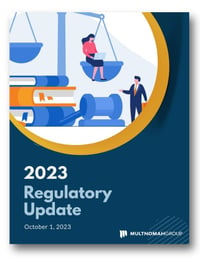Each year, our Technical Services Committee creates a Regulatory Update covering the legislative, regulatory, and litigation developments affecting retirement plans. This year, the Internal Revenue Service (IRS) related several notices affecting plan sponsors and their plans.
IRS Notice Allows for an 'Administrative Transition Period' for Mandatory Roth Catch-up Contributions
The IRS issued Notice 2023-62 on August 25, which extends the enforcement date for the new Roth catch-up provisions. SECURE 2.0 included a provision requiring catch-up contributions for individuals earning over $145,000 to be after-tax Roth-type contributions.
Many SECURE 2.0 provisions require administrative enhancements, but this provision was the most problematic.
Nearly 200 corporations, law firms, and advocacy organizations (including most major recordkeepers) had signed a letter to the House Ways and Means Committee requesting a two-year delay of this provision. This was also a concern for large governmental plans that did not have a Roth option or where the governmental plan was bound by state laws or union contracts that would need to be updated to include the catch-up feature.
With the clock ticking and plan sponsors and recordkeepers scrambling to complete updates by the end of the year, the IRS Notice is a welcome relief.
The rule is still effective Jan. 1, 2023, but the IRS Notice defines the first two taxable years following the effective date as an ’administrative transition period’.
This ’administrative transition period’ allows for the following:
- For individuals earning over $145,000, catch-up contributions made on a pre-tax basis will be treated as satisfying the new rule even though they are not designated Roth contributions, and
- Catch-up contributions made in plans that do not currently offer Roth contributions will be treated as satisfying the rule.
This extends the effective date to Jan. 1, 2026. Even if plan sponsors and recordkeepers have the administrative ability to implement the provision, they should continue to allow participants earning over $145,000 to make pre-tax catch-up contributions.
The notice also stated specific areas where additional guidance will be provided:
- Clarification that the Roth catch-up rule will not apply to individuals who did not have FICA wages the previous year (I.e., self-employed individuals);
- How employers are to treat catch-up contributions for individuals earning over $145,000 as pre-tax contributions during the ’administrative transition period’;
- Addressing multi-employer plans where an employee has eligible wages from more than one employer.
Finally, the notice made it clear that catch-up contributions are still allowed. SECURE 2.0 was written with language that would have removed catch-up contributions from retirement plans, which was never the intent. This notice makes it clear that catch-up contributions continue to be available as a plan option after Dec. 31, 2023.
Additional IRS Notices
Notice 2023-43
SECURE 2.0 requires the IRS to review and expand the EPCRS, issuing final rules by the end of 2024. In May, the service issued notice 2023-43 to provide interim guidance prior to the final rule. The notice is a Q&A format with 12 questions. The answers expand on what is and is not available for self-correction and the circumstances when a plan may be under investigation.
Notice 2023-54
A new rule required ineligible designated beneficiaries to complete all withdrawals of an inherited retirement account within ten years. Guidance interpreting the rule indicated that the beneficiary would be expected to continue the required minimum distributions during the 10-year period if the account's original owner had begun RMDs. Because this was unclear in the original rule, transitional relief was granted for missed RMDs for 2021 and 2022. This notice extends the transitional relief for 2023 as well.
The notice also provided RMD relief related to the SECURE 2.0 provision that increased the required beginning date for RMDs to age 73. Some individuals turning 72 in 2023 had taken what they thought was their initial required minimum distribution. Because the distributions were identified as RMDs they were ineligible to be rolled over to an IRA or other retirement account. This notice extended the 60-day rollover period to Sept. 30, 2023 for distributions made prior to July 31, 2023.
Multnomah Group is a registered investment adviser, registered with the Securities and Exchange Commission. Any information contained herein or on Multnomah Group’s website is provided for educational purposes only and does not intend to make an offer or solicitation for the sale or purchase of any specific securities, investments, or investment strategies. Investments involve risk and, unless otherwise stated, are not guaranteed. Multnomah Group does not provide legal or tax advice. Any views expressed herein are those of the author(s) and not necessarily those of Multnomah Group or Multnomah Group’s clients.


